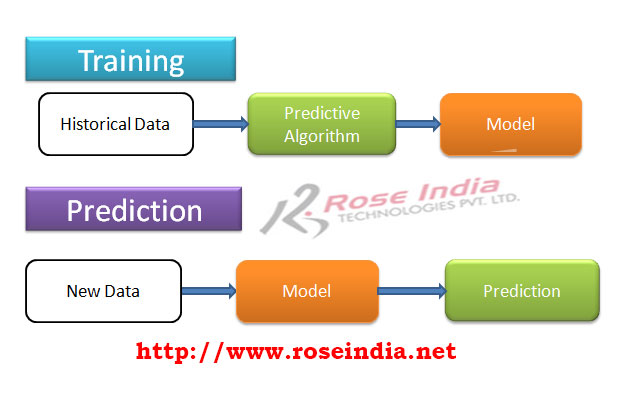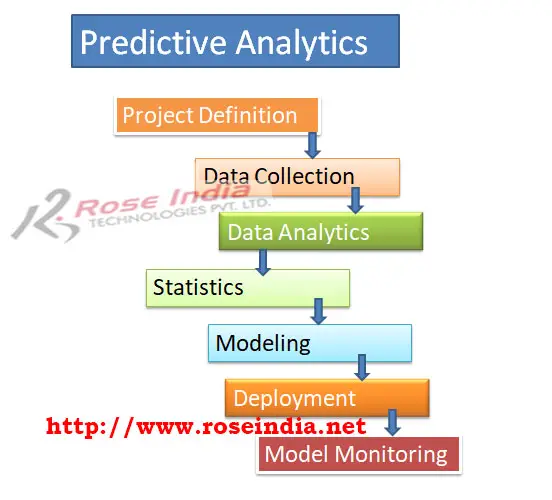What is predictive analytics and what are the steps of predictive analytics?
Predictive analytics is advanced machine leaning technology which uses various mathematical algorithms, data collection, data processing and machine learning activities to predict the future outcome by analyzing past data. Predictive analytics is all about predicting an event or providing indication of future outcome based on the analysis of historical data. Such analytics information is very helpful for the business in making future plan for their business operations.
In this article we will explore predictive analytics in depth and see how it is used in real-life projects. You will be able to understand predictive analytics in much better way. After learning detail concept and implementation of predictive analytics you will be able to better design and develop your projects.
Predictive Analytics is very powerful tool for data analytics. It can analyze both structured and unstructured data from various sources to uncover the patterns hidden in vast collection of data. Predictive analytics can also be used to provide real-time insight of data to business by combining business data with the data from social websites. It is used to predict the future based on the data supplied to the trained model. Predictive analytics helps the business to proactively manage their business.
With the help of training data predictive analytics model is generated and the tested model is used to do prediction on new data.

Predictive analytics is very vast topic and it uses many technologies to provide predictions to the end users. For doing predictive analytics in modern days following technologies are used:
Data Mining: The Data mining is the first step toward predictive analytics; here you collect data for doing predictive analytics.
Statistics: The Statistics is very import in predictive analytics and it is used to do various analysis on the cleaned data. Learning statistics is also a must for predictive analytics.
Modeling: Designing, coding, testing and validating the model is the import tasks under predictive modeling. Here developing a good performing model is very crucial for the business as wrong business discussion may cost a lot to business.
Machine Learning: The machine learning is used to learn from the existing data and then perform various types of calculation to generate better prediction. The machine learning is very important for designing and deploying large scale predictive analytics system. So, developer must learn the machine learning technologies to make application that helps business in managing their system.
Artificial Intelligence: Artificial Intelligence is used to learn from large volume of data and it can be automated also. System can be design to learn from existing data and then predict the outcome when new data is given. The Artificial Intelligence can be used with other system of analytics to build highly accurate predictive analytics system for any type of business.
Data Visualization: Once data is analyzed and predicted it is to be shown to the business users. For this purpose various data visualization tools are used to create nice reports for the businesses. This area is also very important in predictive analytics field. There are many open source and commercial tools available for visualization of data.
Big Data: The Big Data is playing major role is large scale predictive analytics, it provides the space for large scale data store and finally computing power to process data over distributed cluster. The predictive analytic is using tremendous power of Big Data for analyzing data in real-time and in batch process. For quick start, cost factor and ease of maintenance cloud platforms are used heavily for data analytics projects.
So, for any predictive analytics project all these technologies are used together. If you want to learn predictive analytics then you must learn all these technologies. If you are making a team for working on predictive analytics projects then the team you are hiring must have all these skills sets.
The main goal of predictive analytics is to analyze past data and find out risks/opportunity for your future business. Many companies are using predictive analytics for planning and managing their business in today's competitive world.
What are the steps to predictive analytics?
Now let's see the steps of design, developing and deploying highly productive predictive analytics systems. The predictive analytics comes under statistics and it deals with the uncovering the trends of in data. Predictive analytics is used to extract structured and unstructured data to find out patterns hidden inside data. Nowadays predictive analytics also uses many machine learning technologies such as data modeling, machine learning, AI, deep learning algorithm, predictive modeling and data visualization techniques.

Here are the steps in the predictive analytics process:
1. Define project
The first step is to define your project in detail and the project plan must well document project requirement. Project plan must include project objectives, project outcome, project scope, business objectives and data sets to be used. This information is essential for its success and within the allocated budget.
2. Data collection
The actual of development starts with the data collection. Data can be prepared from multiple sources both internal and external such as public or social data. Various data collection techniques can be used for gathering enough data for model training and prediction.
3. Data analytics
The data analytics is the process of checking data on various parameters and correcting to make it ready for predictive analytics. In this process data is cleaned and various modeling is done to discover useful information in the data. Here various tools and technologies are used to understand the data and draw conclusion about the content of data.
4. Statistics
The Statistical analysis of data is very import in this field. It is used for validating the assumptions, hypothesis and testing with the help of standard statistical model. Developer should have good experience in statistics for working on the predictive analytics project.
5. Modeling
Various machine learning and deep learning models can be created from the historical data to predict the future based on the new data supplied to the model. Here Data scientists are using multi-model evaluation process to get better and more accurate results.
6. Deployment
After final testing and validation of model it is deployed on the production which can run in real-time or as batch job to give predictions to the business. Various reporting tools can be used for displaying the results to end user. The deployed model can be used for business to predict when new data comes.
7. Model monitoring
Data scientist must monitor the prediction generated by model and retrain or update the model to enhance its output. Model must be monitored as to find out if its is working satisfactorily. If there is any deviation in the prediction then re-training of the model is required.
In this article we have learned about predictive analytics in much detail. You can find more tutorials at Data Science - Guide to Data science, machine learning, deep learning and artificial intelligence.
